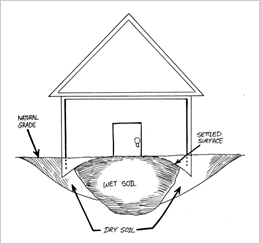Causes of Foundation Problems
Water is the main enemy in expansive soils problems. There is either too much water, causing the soil to swell, or not enough, causing the soil to shrink.
If all soil beneath a foundation swells uniformly or shrinks uniformly it is unlikely to cause a problem. But when only part of the foundation heaves or settles, differential movement causes cracks and other damage.

Most differential movement is caused by differences in soil moisture. After construction, soil beneath part of the foundation becomes wetter or drier than the rest of the soil.
Here is why this happens:
When there is a gain in soil moisture:
This is the most serious threat since the swelling potential of expansive soils is much greater than the shrinkage potential. Moisture gain can come from plumbing leaks, subsurface water like wet weather or a high water table, or surface water. Surface water is improper drainage of landscape water or rainwater.
Poor drainage can be a major contributor to soil moisture gains. Roof runoff should be directed away from the house through the use of gutters. Gutter downspouts should not be permitted to discharge the water next to the foundation. Surface drainage next to the foundation should slope away from the house approximately ¼ " per foot.
When there is a loss of soil moisture:
The soil may be at or near its optimum moisture content when the foundation is built, but it may lose enough moisture during a drought to cause the foundation to settle. Settlement is usually greatest near the perimeter of the foundation where the soil dries most quickly.
Extremely low or high soil moisture during construction
If the soil content is very low when a slab-on-grade foundation is poured, soil to the slab edges regains moisture first because it is directly exposed to rain water or irrigation water.
If the soil moisture is extremely high during construction, the slab will hold in the moisture except at the perimeter, where it is exposed to more wind and heat. In cases like this the slab edge loses moisture at a different rate than the soils under the house and the house will settle.
Poor Pre-Construction Compaction of the building pad

Slab-on-grade foundations depend on the uppermost soil layers to provide bearing capacity to support the structure and keep the foundation stable. If the bearing soil was not compacted properly during grading, the foundation is subject to settlement as the supporting soil consolidates.
Also of concern is when a structure is supported by various soil conditions. In this case the house may settle differentially. As an example, if one half of the foundation sits upon expansive clay and the other half bears on select fill and/or rock, the amount of seasonal movement will vary from one half to the other half. If the foundation system is not properly designed, the differential movement may cause damage to the foundation and structure.

